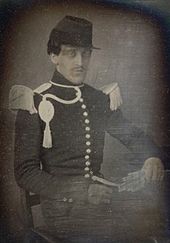Paul Gachet
Paul-Ferdinand Gachet (born July 30, 1828 in Lille , † January 9, 1909 in Auvers-sur-Oise ) was a French doctor . He became known through the treatment of the painter Vincent van Gogh during his last weeks in Auvers-sur-Oise. Van Gogh had portrayed him in 1890 . Gachet was a friend and promoter of the Impressionist art movement, whose painters he supported, and an ambitious hobby painter himself. He signed his pictures with "Paul van Ryssel", which referred to his birthplace, whose Flemish name is Ryssel .
Life
Gachet was born in Lille, where he also spent his childhood. Around 1845 his family moved to Mechelen because Gachet's father had opened a new branch of the company he worked for there.
Gachet studied at the University of Paris , among others with Armand Trousseau , and graduated in 1858 with the thesis Étude sur la Mélancolie . He then worked as a doctor at the Bicêtre and Salpêtrière clinics before opening a private practice in Paris. There he met Gustave Courbet , Jules Champfleury , Victor Hugo and, in the early 1870s, Paul Cézanne , who was allowed to use Gachet's studio in Auvers-sur-Oise near Paris. In 1882 he treated Auguste Renoir , who was suffering from pneumonia . Gachet was also a friend of the chemist Henri Nestlé and prescribed his new baby milk to some of his little patients.
Gachet died in 1909. His grave is in Division 52 of the Père Lachaise cemetery in Paris .
Gachet and Vincent van Gogh
Vincent van Gogh's brother, the art dealer Theo van Gogh , sought Gachet's advice, as his expertise and friendship with artists made him the ideal doctor for Vincent's treatment. Shortly after Gachet's first visit, however, he doubted that Gachet could help him.
Gachet later drew a lot of criticism because he could not prevent van Gogh's suicide after ten weeks of treatment. However, according to Wilfred N. Arnold, van Gogh was either unable or unwilling to follow the doctor's advice to quit smoking and to give up alcohol. However, no other doctor of the time would have succeeded in giving van Gogh's disease a different direction. In the end, however, Gachet failed to bring Vincent van Gogh to professional treatment for his suicidal gunshot wound.
Portraits
Paul Gachet, portrayed by Ambroise Detrez (1850/52)
Vincent van Gogh: “ Portrait of Dr. Gachet "(1890, second version)
Paul Gachet, portrayed by Norbert Goeneutte (1891)
literature
- Anne Distel, Susan Alyson Stein: Cézanne to Van Gogh: The Collection of Doctor Gachet. Metropolitan Museum of Art, New York 1999, ISBN 0-87099-903-6 .
Web links
Individual evidence
- ↑ This is how Gachet's son Paul-Louis Gachet signed with Louis van Ryssel
- ↑ A detailed chronology of Doctor Gachet's life, compiled by his son, can be found in Distel & Stein 1999, pp. 273–288
- ^ Paul Gachet in the Find a Grave database . Accessed July 9, 2018.
- ↑ Letter 648
- ^ Wilfred N. Arnold: Vincent van Gogh: Chemicals, Crises, and Creativity. Birkhäuser, Boston 1992, ISBN 0-8176-3616-1 , p. 66.
- ^ Christian Saehrendt : Lonely and crazy, Germanic and ingenious - how van Gogh became a cult figure in Germany . In: Neue Zürcher Zeitung . November 2, 2019 ( nzz.ch [accessed November 2, 2019]).
| personal data | |
|---|---|
| SURNAME | Gachet, Paul |
| ALTERNATIVE NAMES | Gachet, Paul-Ferdinand (full name); Ryssel, Paul van (pseudonym) |
| BRIEF DESCRIPTION | French doctor and painter |
| DATE OF BIRTH | July 30, 1828 |
| PLACE OF BIRTH | Lille |
| DATE OF DEATH | January 9, 1909 |
| Place of death | Auvers-sur-Oise |







